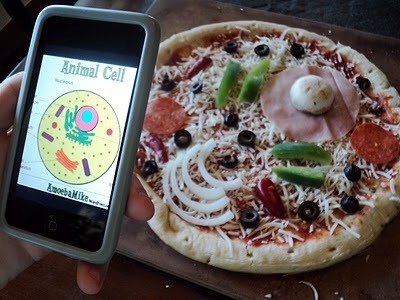Genetics, Part Two-A: Animal Cell Model
This week we learned about cells.
We made a model of an animal cell, using Jello. (Directions for an example of this can be found at Enchanted Learning.) They estimate the appropriate grade level as 5-7th, but I did it with some older and some younger than this.
Pin It
Light colored Jello works the best for this but I forgot we were going to do this week and had to use what we happened to have in the cabinet, which was orange. I decided to make the animal cell in a pie pan so that it would be circular. You will also need various candies used to represent the parts of the cell. I just got out our bowl of candy and used what we had on hand. Our choices are different from the ones at Enchanted Learning.
Light colored Jello works the best for this but I forgot we were going to do this week and had to use what we happened to have in the cabinet, which was orange. I decided to make the animal cell in a pie pan so that it would be circular. You will also need various candies used to represent the parts of the cell. I just got out our bowl of candy and used what we had on hand. Our choices are different from the ones at Enchanted Learning.
First, make the Jello but with a bit less water than the instructions call for. This will make the gelatin a little stiffer and will make the cell components stay in place better. Put the Jello in the refrigerator for about an hour to set a little.The gelatin will represent the cytoplasm of the cell. Then we began adding the cell components and we went over each candy item and what part of the cell it represented as we built our model and then sketched it.
centrosome - a small body located near the nucleus - it has a dense center and radiating tubules. This is where microtubules are made. During cell division (mitosis), the centrosome divides and the two parts move to opposite sides of the dividing cell. (peppermint)
cytoplasm - the jellylike material outside the cell nucleus in which the organelles are located. (jello)
Golgi body - (also called the Golgi apparatus or Golgi complex) a flattened, layered, sac-like organelle that looks like a stack of pancakes and is located near the nucleus. It produces the membranes that surround the lysosomes. The Golgi body packages proteins and carbohydrates into membrane-bound vesicles for "export" from the cell. (Mike and Ikes)
lysosome - (also called cell vesicles) round organelles surrounded by a membrane and containing digestive enzymes. This is where the digestion of cell nutrients takes place. (spice drops)
mitochondrion - spherical to rod-shaped organelles with a double membrane. The inner membrane is infolded many times, forming a series of projections (called cristae). The mitochondrion converts the energy stored in glucose into ATP (adenosine triphosphate) for the cell. (Gummy worms)
nucleus - spherical body containing many organelles, including the nucleolus. The nucleus controls many of the functions of the cell (by controlling protein synthesis) and contains DNA (in chromosomes). and
nuclear membrane - the membrane that surrounds the nucleus. (marshmallow)
nucleolus - an organelle within the nucleus - it is where ribosomal RNA is produced. Some cells have more than one nucleolus. (gumball)
ribosome - small organelles composed of RNA-rich cytoplasmic granules that are sites of protein synthesis.
rough endoplasmic reticulum - (rough ER) a vast system of interconnected, membranous, infolded and convoluted sacks that are located in the cell's cytoplasm (the ER is continuous with the outer nuclear membrane). Rough ER is covered with ribosomes that give it a rough appearance. Rough ER transports materials through the cell and produces proteins in sacks called cisternae (which are sent to the Golgi body, or inserted into the cell membrane). (M & M's)
smooth endoplasmic reticulum - (smooth ER) a vast system of interconnected, membranous, infolded and convoluted tubes that are located in the cell's cytoplasm (the ER is continuous with the outer nuclear membrane). The space within the ER is called the ER lumen. Smooth ER transports materials through the cell. It contains enzymes and produces and digests lipids (fats) and membrane proteins; smooth ER buds off from rough ER, moving the newly-made proteins and lipids to the Golgi body, lysosomes, and membranes.
vacuole - fluid-filled, membrane-surrounded cavities inside a cell. The vacuole fills with food being digested and waste material that is on its way out of the cell. (Twizzlers)
Once you are finished, put in the refrigerator to fully set. Then you can eat it, if you wish.
Another excellent idea is to make the model from a pizza! Journey to Excellence shows this example.
Next week we will be making models of Mitosis with three colors of pipe cleaners.




